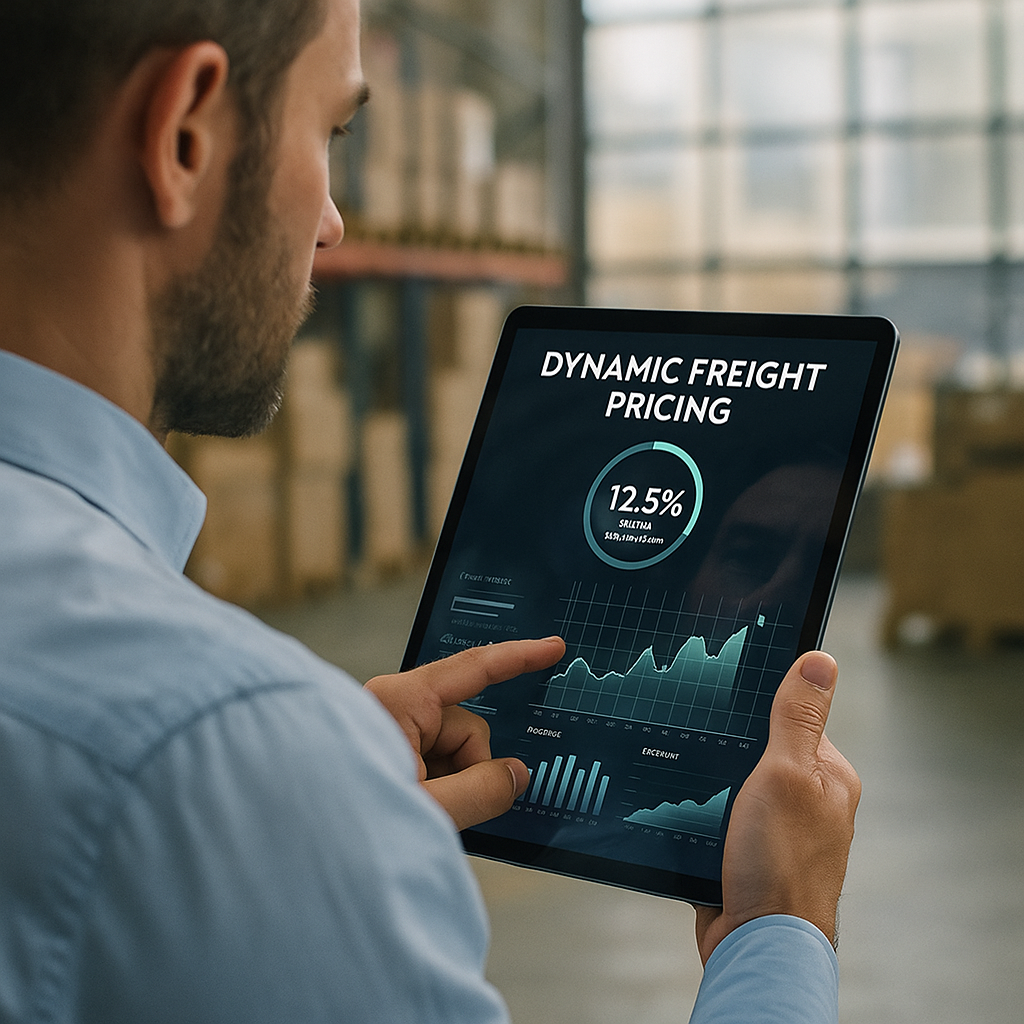Let's Get Straight to the Point
Dynamic pricing in freight adjusts shipping costs in real time using AI, machine learning, and market data.
It maximises profits, improves efficiency, and enhances customer satisfaction by aligning prices with demand and market conditions.
While challenging to implement, it’s essential for staying competitive in the evolving logistics industry.
To learn how technology is transforming freight management, visit Cario.com.au - the platform helping businesses optimise pricing, efficiency, and visibility across every shipment.

What is Dynamic Freight Pricing?
At its core, dynamic freight pricing is a pricing strategy that adjusts shipping costs based on real-time data and various external factors, including market demand, fuel prices, and shipment volume.
It represents a significant departure from traditional static pricing models, which rely on fixed rates that often fail to reflect market dynamics.
Key Features of Dynamic Freight Pricing
Adaptability: Prices fluctuate based on changes in market demand and other variables.
Technology Integration: Utilises advanced tools like AI, machine learning, and automation to generate accurate pricing.
Customer-Centric: Enables fair and tailored pricing to align with customer preferences.
For logistics companies, the shift to dynamic pricing systems is not just a way to offer competitive prices but a means to remain agile in an industry heavily influenced by market trends and external factors.
Understanding the Mechanism Behind Dynamic Pricing
Dynamic pricing operates on advanced algorithms designed to process and interpret massive amounts of real-time data. This includes historical trends, current demand, and external factors like fuel prices and labour costs.
How It Works
Data Collection: Systems gather information from various sources, including supply chain operations, customer behaviours, and market analytics.
Algorithmic Analysis: Algorithms process data to identify patterns and forecast market trends.
Real-Time Adjustments: Pricing is updated dynamically to align with current market conditions.
The reliance on predictive analytics and complex data analysis ensures that logistics companies can adjust prices precisely, reducing the risks associated with overpricing or underpricing.
Benefits of Dynamic Pricing
The adoption of dynamic pricing models has revolutionised the transportation and logistics industry, offering a range of benefits:
1. Maximising Profit Margins
By responding to market demand and demand fluctuations, logistics companies can charge higher prices during peak periods and offer discounts during slower times. This flexibility supports sustained profitability even in volatile markets.
2. Operational Efficiency
Dynamic pricing reduces reliance on manual calculations, enabling companies to focus on streamlining logistics operations. Dynamic pricing engines automate the production of freight quotes, saving time and improving accuracy.
3. Improved Customer Satisfaction
Fair and transparent pricing enhances trust. Customers appreciate optimal pricing tailored to their needs, leading to improved customer service and loyalty.
4. Enhanced Competitive Edge
Companies employing dynamic pricing strategies in a sector driven by competition can stay ahead by offering competitive prices aligned with current market demand.
These benefits underline the transformative impact of dynamic pricing in improving both profitability and customer relations.

Implementing Dynamic Freight Pricing Effectively
Adopting dynamic freight pricing requires a strategic approach involving technology integration, data analysis, and ongoing monitoring. Here’s how companies can do it effectively:
1. Data Collection and Analysis
Logistics companies need access to accurate and comprehensive market data to implement dynamic pricing systems. This includes:
Historical data for identifying trends.
Real-time data for capturing current market conditions.
Information on customer demands and competitor pricing.
2. Technological Integration
Investing in advanced tools like AI and machine learning is critical. These technologies can:
Process vast datasets with speed and accuracy.
Generate most optimised prices in real time.
Automate repetitive tasks, freeing up resources for more strategic work.
3. Ongoing Monitoring
External factors like fuel costs, labour shortages, and seasonal demand influence the logistics sector. Continuous monitoring of these variables is essential to adjust pricing effectively.
Dynamic Pricing Models for Freight Forwarders
Freight forwarders stand to gain significantly from adopting dynamic pricing models, which enable them to manage costs, optimise shipments, and improve service quality.
Key Applications
Minimising Empty Miles: Adjusting prices to consolidate loads and reduce unprofitable trips.
Tailored Pricing: Customising rates for specific routes, clients, or shipment types.
Testing and Iteration: Proactively refining pricing strategies to reflect market dynamics.
By using dynamic freight pricing, forwarders can confidently address challenges like fluctuating fuel prices and varying customer demands.

Freight Pricing Strategies for Different Modes of Transportation
Dynamic pricing can be adapted to suit various modes of transportation, ensuring efficiency and profitability across the board.
1. Ocean Freight
For ocean shipping, dynamic pricing factors in global trade volumes, port congestion, and fuel surcharges. Real-time updates allow shippers to remain competitive even during economic downturns.
2. Air Cargo
With its fast-paced nature, air cargo benefits from dynamic pricing engines that adjust rates in response to demand fluctuations and weather disruptions.
3. Truckload and Rail
Dynamic models in trucking and rail services optimise headhaul and backhaul routes, reducing costs and enhancing overall efficiency.
Tailored freight pricing strategies ensure that logistics companies can adapt to the unique challenges of each transportation mode.
Common Challenges and Solutions
While the benefits of dynamic pricing systems are evident, implementation can be challenging.
1. Challenges
Data Reliability: Ensuring the availability of accurate real-time data.
Overpricing Risks: Avoiding scenarios where pricing becomes prohibitive for customers.
Complexity: Handling the intricacies of complex data analysis and integrating multiple datasets.
2. Solutions
Invest in robust dynamic pricing engines to minimise errors.
Use machine learning to refine algorithms over time.
Conduct regular audits to validate pricing accuracy.
The Role of Technology in Dynamic Pricing
Technology is a cornerstone of dynamic pricing strategies, enabling logistics companies to analyse, adjust, and implement pricing efficiently.
Key Technological Enablers
AI and Machine Learning:
Develop predictive models to anticipate market trends and optimise pricing decisions.
Dynamic Pricing Engines:
Generate instant freight quotes and reduce manual work.
Data Analytics Tools:
Integrate historical data, real-time data, and competitor pricing for comprehensive insights.
These innovations empower companies to remain agile, ensuring they can adapt to market volatility and maintain a competitive edge.
Best Practices for Dynamic Pricing
To succeed with dynamic freight pricing, companies must adhere to proven best practices:
Leverage Real-Time Data:
Use data analytics to capture and interpret market changes in real-time.
Prioritise Customer Needs:
Align pricing with customer preferences to build loyalty.
Monitor Market Trends:
Stay informed about external factors like fuel prices and competitor actions.
Invest in Training:
Equip teams with the skills to manage and optimise dynamic pricing systems.
By following these practices, logistics companies can unlock the full potential of dynamic pricing and thrive in a competitive market.

Conclusion
In the freight market, dynamic pricing is more than a pricing strategy—it’s necessary to adapt to market changes effectively. By using real-time data, artificial intelligence, and predictive analytics, companies can optimise freight pricing to reflect market dynamics accurately.
The benefits of dynamic pricing extend beyond profitability. They enable logistics companies to enhance customer satisfaction, improve supply chain operations, and maintain fair pricing in a volatile environment.
Embracing dynamic pricing models is no longer optional—it’s the key to success in the evolving transportation and logistics industry.
FAQs
1. What is dynamic pricing in freight?
Dynamic freight pricing adjusts real-time shipping costs based on factors like market demand, fuel prices, and shipment volume. It uses advanced technologies like AI and machine learning to ensure accurate and competitive pricing.
2. How does dynamic freight pricing benefit logistics companies?
Dynamic freight pricing helps companies maximise profits, reduce operational costs, and improve customer satisfaction. It ensures fair and optimised pricing that adapts to market trends and demand fluctuations.
3. What technologies are used in dynamic pricing systems?
Dynamic pricing systems rely on AI, machine learning, and predictive analytics. These tools process real-time data and historical trends to calculate and adjust prices efficiently.
4. What are the challenges of implementing dynamic pricing?
Challenges include obtaining accurate real-time data, managing complex algorithms, and avoiding risks like overpricing. Robust dynamic pricing engines and continuous monitoring can address these.
5. How can dynamic pricing improve customer satisfaction?
Dynamic pricing ensures fair and tailored rates by aligning prices with current market conditions. This transparency and adaptability enhance trust and meet customer expectations.
